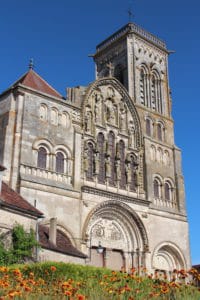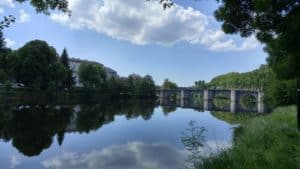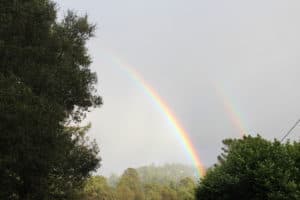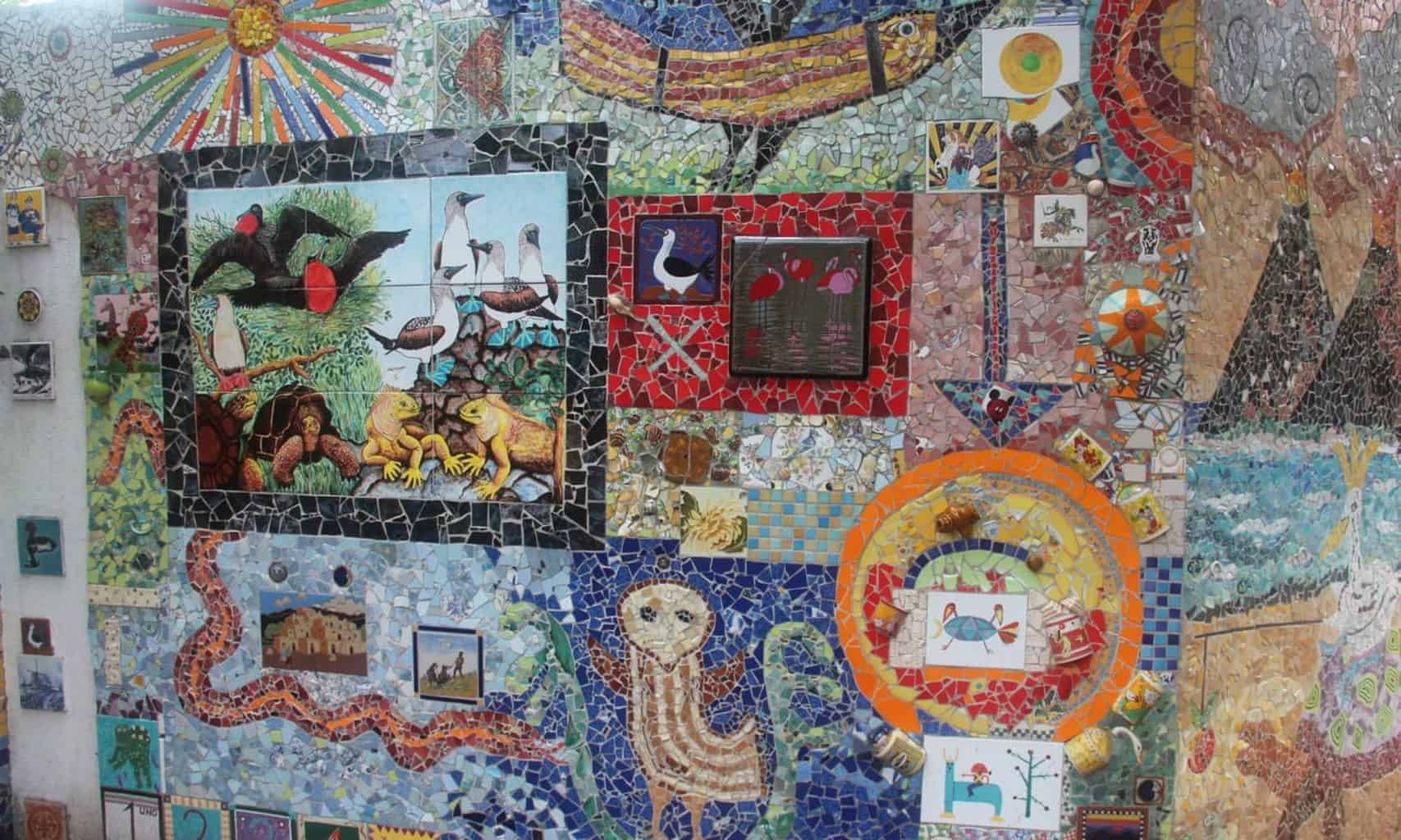France’s historic Vézelay route

The Chemin Vézelay (Latin: Lemovicensis) is one of the four medieval pilgrim routes from France. It begins in the small, charming hilltop village of Vézelay, where the 11th-century Romanesque Basilica of St. Magdalene continues to draw visitors to this gorgeous religious site. This is in the north-central region of France, known as the Bourgogne (Burgundy)-Franche-Comté.
Vézelay was a delightful place to start our journey. From the bus stop, we climbed the short distance uphill to the basilica (and our accommodations) past the lovely centuries-old houses that line the main street. The population today is only 400 people; at one time the population was almost 10,000.
Mary Magdalene
It’s no wonder that the town and the basilica were designated UNESCO World Heritage sites–they have an important religious and cultural history. A large part of that history is connected to Mary Magdalene.
It appears that Vézelay’s Christian history began in 860 AD, with the construction of a Benedictine monastery. A monk, Baudillon, brought relics, said to be the bones, of Mary Magdalene, from Saint-Maximin-la-Sainte-Baume in southern France. The pope, in 1058, declared the relics to be authentic. As word spread, it became an important place for Christians’ pilgrimage, and also for pilgrims to begin a walk to Santiago.
However, though some sources believe that the relics were authentic and are still in Vézelay, others question the matter. It is a fact, though, that the decline of pilgrimage to and from Vézelay started after the “well-publicized discovery in 1279 of the body of Mary Magdalene at Saint-Maximin-la-Sainte-Baume in Provence.”
Our first section: Vézelay to Saint Amand Montrond
For today’s pilgrims and other visitors to the village, there remains much to enjoy. Not only the basilica, but also some of the shops–which refreshingly–do not bombard you with kitsch and gaudy displays. Vézelay is in large part an artist community. The small, but attractive Zervos museum is well worth a visit. It has a diverse collection of modern art by such as Picasso, Miro, Calder, and more.
The route divides as it leaves Vézelay — the Northern route goes through Bourges, the southern route through Nevers. We chose the Bourges route because the sections looked more doable (considering stages, accommodations, and the slightly shorter distance).
“Though the Bourges route is slightly shorter and much flatter, with many large forests and cornfields, [because of that] to some, more monotonous. Bourges Cathedral is well worth a visit and some say this city is more interesting than Nevers. (The Nevers route, also passing through Saint-Amand-Montrond and La Châtre is 31.6 km longer than the Bourges route, unless the variant via Augy-sur-Aubois is chosen which halves the extra distance. The terrain is more undulating and varied, and Nevers has the shrine of Saint Bernadette Soubirous (of Lourdes) which is a pilgrimage centre in its own right)”. Info from the Confraternity of St. James.
Our second section: Saint Amand Montrond to Limoges
We did another 120+ miles in 2018, passing through the village of Gargile sse where the routes reunited, and ending in the charming city of Limoges, which is west-central France. Although guidebooks may divide the Vezelay it into 36 stages, of 20 and 30 km, we generally did shorter walks depending upon the accommodations available.
sse where the routes reunited, and ending in the charming city of Limoges, which is west-central France. Although guidebooks may divide the Vezelay it into 36 stages, of 20 and 30 km, we generally did shorter walks depending upon the accommodations available.
Our third section: Limoges to Bazas (near Bordeaux)
In May 2019, Ralph and I did a third section. we resumed our hike where we left off in Limoges and ended in Bazas (population 4,150). Because we enjoyed our short time in Limoges the previous year, we were happy to return.
Limoges, with its population of 141,176 is large enough to have many good restaurants and more than one main street, so we knew we would enjoy spending an extra day there before we began this year’s trek. We assumed that in the weeks ahead, we would find few places with sizable populations because we were going to be walking through rural areas. The Limousin is a land of forests and springs, of extensive cattle and sheep-raising.
Our first night’s accommodation after leaving Limoges was at a working farm with a few rooms for overnight guests. Our hosts drove into town to pick us up and return us. We ate dinner and breakfast with them and the other couple spending the night.
On our third hiking day, we stayed in the village of Chalus, where Richard the Lion-Heart, King of England from 1189 to 1199 CE, died after a battle during the Third Crusade. Though we didn’t tour the privately-owned castle where he passed away, it was exciting to view the many chateaus and towers in this area. Click here to read about the castle.
As we expected, most settled areas we went through were small towns and villages–usually one main street with businesses where the rural people came to shop for necessities.
Typically we were the only guests staying in the B&Bs, gites, or Chambre de Hote. If the hosts were more than a kilometer out of town, they would pick us up and deliver us back to the trail. When there were no restaurants nearby, we would eat with the hosts.
It was good that we could eat with them because we saw very few people walking on this Camino route. Luckily, most hosts spoke English pretty well — in fact, several were from England. I found it fascinating to hear the stories of how they made these significant life changes.
There were pilgrim accommodations in many of the towns — for the most part, we didn’t look into them. In Pelligrue, we stayed in one right in the center of town above the tourist bureau. Once again, we had the place to ourselves.
Several times, we stayed in places that had been converted from old stone barns. It was fascinating to see how these abandoned places had been transformed into handsome, two-story guesthouses with architectural details and furnishings reminiscent of luxurious homes featured in Town & Country or Southern Living.
Toward the end of our hike, we were in the Gironde region, southwest France, and found ourselves walking through vineyards, the grapes of which may well end up in our next lovely glass of Bordeaux. From our hike’s end in Bazas, we found a ride share through Blablacar.com to Bordeaux and then continued on by train to Paris.
Our Fourth (and final) section: Bazas to St. Jean Pied du Port (135 miles)
We enjoyed returning to Bazas (especially after a year’s delay because of COVID-19). The city has a lovely Basilica and city center and this time we found a farmer’s market bustling with activity.
We have found the waymarking of the route improved. There were more markings. We noticed that the signs are gradually changing from the earlier red and white or red and yellow, to the yellow and blue that you’ll see on the Frances.
As we continued south, we found few vineyard, primarily plantation farms of pines interspersed with fields of corn and some sunflowers. The wilder forests have more variety — including oaks and deciduous trees and rich understory plants. A day or two before you reach St. Jean Pied de Port, between the town of Saint-Palais and of Ostabat, is the “stele” marking the meeting of three pilgrimage ways to Santiago de Compostela. The stele is called the Stele of Gibraltar and is in the shape of a Basque tombstone.This is where three of the four main routes of the Chemin de Saint-Jacques come together: the Paris/Tours, the Voie de Vézelay, and the Chemin du Puy.
From there we had a steep climb on a road to the top of the hill and the chapel: Chapelle de Soyarce. The chapel had several trees around it and several pilgrims and others resting on the benches or trying to peek into the closed chapel. From this height, you’ll have breathtaking views of the valleys through which you have walked and toward the Pyrenees that lie ahead.
Reaching St. Jean Pied de Port again was a delight. And unlike our previous time there, we had a more leisurely stay. We stayed overnight and were able to see many places we hadn’t before — the shops, the citadel, and more.
And then, having extra time, we took the short trainride to Bayonne. Thought we had three nights there, we agreed that a few more would have been welcome because there was much to see in this interesting port city near the Atlantic Coast.
Practicalities
Walking the Vézelay is a very different experience than walking the Frances. As the CSJ says in their write up, “It is a route for pilgrims who are looking for tranquility and a meditative environment.” Translated that means — except in the larger cities, on market days, or during festival, you will see very few people. Most days we didn’t see anyone on the trail.
Getting to Vézelay, and other towns along the route, is not the easiest process. So far, we have flown into Paris and then taken a train and/or bus to our starting point. To get back home is also usually a multi-stage event, but we have had great experiences using blabla.car (car-share for a fee). Finding options is pretty easy with Rome2Rio.com
The Vézelay route in general is adequately marked–usually with the scallop shell (the signs with red and white lines are for the 654, ignore them, that’s another route). Increasingly, signs with blue and yellow lines are being placed.
 The terrain is varied, the landscape diverse. It has been described as “a demanding route through a sparsely settled, rural environment.” Most of the towns are small, much land is agricultural, raises livestock, or is forested.
The terrain is varied, the landscape diverse. It has been described as “a demanding route through a sparsely settled, rural environment.” Most of the towns are small, much land is agricultural, raises livestock, or is forested.
Spring and fall are typically the best times for travel. In winter, you would encounter a great deal of snow and ice. In summer, it can be very hot. In spite of starting our hikes in late April and early May, we experienced days with temperatures in the 90’s and low 100’s.
Accommodations
You will not find a lot of competition for accommodations–for the most part, this is not a tourist destination. And, though increasing, there are not a lot of places to stay. We stayed in a variety of accommodations, but because there are few large cities, often there was no choice. A back bedroom, a pilgrim refuges, small or large hotels, chambres d’hôte (bed & breakfasts), or gîtes d’étape. However, we liked the variety of places we stayed and particularly enjoyed being able to converse and eat with our hosts.
“The route has simple but sufficient facilities, calling upon the rigour of the pilgrim’s commitment (whatever his deeper underlying motive), in the context of a relatively deserted rural environment sufficient to discourage the ‘tourist’, and to deter therefore all those who embark on the pilgrimage in a spirit which is not ‘serious’ (i.e. who want simply to ‘play at’ being a pilgrim).” Quotations from the Confraternity of St. James, based in London.
We relied heavily on Booking.com and usually called the day before to arrange. Arriving without accommodations can be problematical because sometimes hosts do not live on site and will have to arrange to meet you (and prepare a meal, if that is part of the service).
Far different from the Frances route
We saw very few people on the route, or in the places we stayed, but those we did meet were helpful and friendly–even putting up with our poor French. But, for many people, myself included at times, seeing so few people can feel rather lonely.
Resources
Les Amis et Pèlerins de Saint Jacques sur la Voie de Vezelay has guides for the sections from Vézelay to Gargilesse. (French)
The Association des Amis des Pèlerins de Saint-Jacques et d’Etudes Compostellanes du Limousin Périgord provides information that covers the combined route from Gargilesse to Saint-Jean-Pied-de-Port. (French)
Confraternity of Saint James Link takes you to their overviews of the route, and they also sell a booklet in English that will complement the two previous sources.
Les Amis et Pèlerins de Saint Jacques sur la Voie de Vézelay (French) web site has information on accommodations, packing lists, credentials, guidebooks, maps and much more.
The Société Landaise des Amis de Saint Jacques et d’Etudes Compostellanes has a section on the Vézelay with a list of
stages, albergues and general information. (French, English and German)
An American pilgrim has created a Facebook page under: Way of St. James–Voie de Vézelay–Camino de Santiago.

Many thanks for your overview Susan. My wife and I have walked four Caminos and decided that after our last (Del Norte/Primitivo in 2023) that was it, but we are now looking at the possibility of walking the Via Vezelay – your site and insights have been most useful and are appreciated.
Many thanks,
John
Hi John, Thank you for your comments. It’s been a while since we completed the Vezelay route, but it remains Ralph’s favorite. If we had the time, we’d do it again. You may have noticed that we have enjoyed all of our hikes in France. While the accommodations (in general) are more limited than on the Spanish routes, the hospitality and food are great!